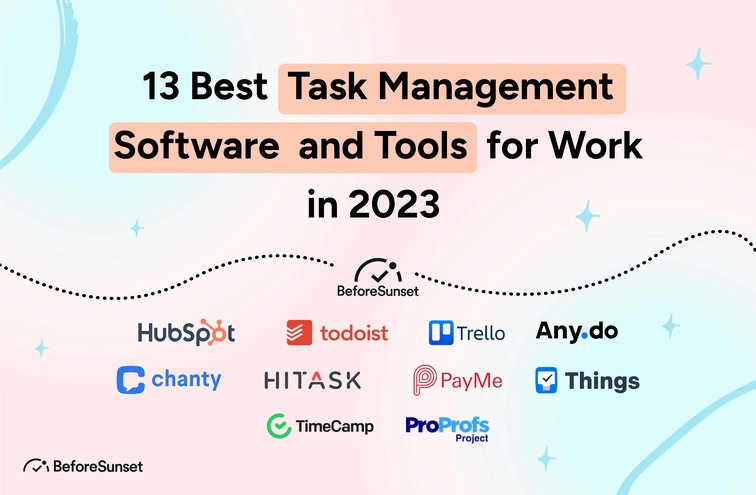I am sure you have a hectic schedule and need to juggle multiple task at a time, right? You may use Evernote and Google Calendar to keep your reminders organized. But as your workflow and tasks become more complex over the years, you start wondering whether there are better task management software and tools available in the market. Whether you run a startup or lead a team of remote employees — good project management is a must to ensure everyone stays on track and is able to work productively. This blog will show you 13 task management software that will up your productivity.
What is Task Management?
The process of arranging, planning, tracking, and regulating activities within a project or workflow is referred to as task management. It entails overseeing the administration of distinct tasks as they advance toward completion.
In order to successfully manage their workloads, prioritize their tasks, and accomplish their objectives, individuals, teams, and organizations must master task management. In task management, tasks are frequently characterized as certain activities or actions that must be carried out in order to achieve a desired result.
What is the Use of Task Management Software?
The goal of task management software is to increase productivity and enable people, teams, and organizations streamline their task management procedures. Here are some typical applications and advantages of task management software:
Task Organization: Users may create, arrange, and categorize tasks using task management software. This makes it easier for individuals and teams to see their assignments, priorities, and due dates clearly.
Task Tracking: With the use of task management software, users may keep tabs on the status of their tasks in real time. The task status, completion rate, and any relevant notes or modifications are all visible. This makes for better oversight and responsibility.
Collaboration and Communication: Task management software frequently comes with collaborative capabilities like comments, file attachments and alerts. These tools let team members communicate and work together, making it simpler to exchange updates, pose questions, and offer feedback.
Deadline Management: Setting deadlines for work using task management software enables users to get alerts or reminders when due dates are approaching or missed. This aids in setting job priorities and guaranteeing prompt completion.
Resource Allocation: Some task management tools allow users to assign jobs to certain people or teams using resource management features. This aids in appropriately dispersing tasks and avoiding resource saturation.
Management of Dependencies: Users of task management software can specify the conditions under which one work must be finished before another can start. This makes it easier to visualize task linkages and guarantees that activities are carried out in the proper order.
Reporting on Progress: Task management tools frequently include reports and visualizations that offer insights into task progress, burden allocation, and team performance. Making data-driven decisions and assessing productivity are made easier with the aid of these reports.
Automation and Integration: Task management applications may be automated and integrated with a variety of different tools and platforms, including calendars, email, project management applications, and team collaboration tools. This facilitates smooth data synchronization and job automation, lowering human labor requirements and increasing productivity.
Accessibility on mobile devices: Many task management programs have mobile applications that let users access and manage tasks while on the go. With this freedom, mobile workers may operate remotely and produce more effectively.
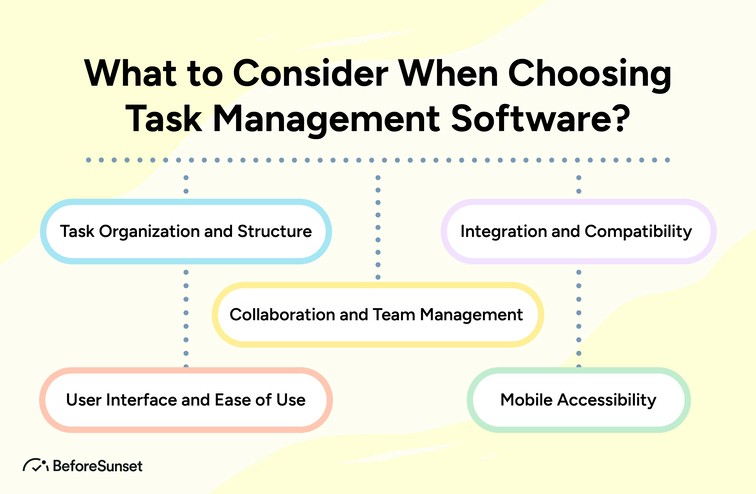
What to Consider When Choosing Task Management Software?
There are several things to take into consideration while selecting task management software. Determine the main elements needed for efficient task management by first evaluating the unique requirements of your team or company. These features should include task creation, assignment, tracking, communication tools, and reporting capabilities.
Take into account the software's usability and user interface because an intuitive interface may increase adoption and productivity. In order to guarantee smooth integration and accessibility, compatibility with your current platforms and devices is essential.
Consider scalability as well because your task management requirements can change in the future. To protect your data and guarantee that the software complies with your organization's rules, evaluate the security measures in place. Consider the price of the program and the value it offers, taking into consideration both the original investment and any recurring costs.

1. BeforeSunset
New and powerful task management tool BeforeSunset aids in keeping teams and individuals organized and productive. It is easy to use and full of features that will help you finish your work before sunset.
Users of BeforeSunset may create tasks and move them to their calendar with ease. It helps with time blocking and allocating a specific time frame. Users may easily tailor and prioritize their tasks using the software's numerous features, such as labels and time tracking. BeforSunset's ability to share tasks and projects with team members for quick communication facilitates collaboration. You can also be aware of how your coworkers are feeling without asking for it.
The program also offers real-time device synchronization, making sure that your tasks are available from any location whether you're using a PC, smartphone, or tablet.
Because of its simplicity, versatility, and cross-platform usability, BeforeSunset caters to a diverse range of consumers, from individuals handling personal tasks to teams working on large projects. The BeforeSunset app may help you stay organized, set priorities, and efficiently complete tasks whether you're a student, professional, or business owner.
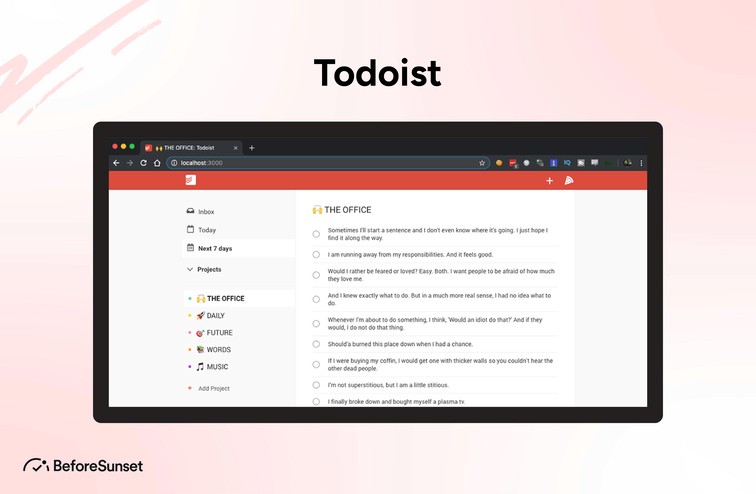
2. Todoist
Popular and adaptable task management tool Todoist aids in keeping teams and people organized and task-focused. Todoist has established a reputation as one of the top task management programs on the market because to its user-friendly layout and extensive capabilities.
Users of Todoist may create tasks and group them into projects and smaller tasks, giving complicated processes a hierarchical structure. Users may easily tailor and prioritize their tasks using the software's numerous features, such as due dates, priority, labels, and reminders. Todoist's ability to share tasks and projects with team members, assign tasks to particular people, and write comments for quick communication facilitates collaboration.
The program also offers real-time device synchronization, making sure that your tasks are available from any location whether you're using a PC, smartphone, or tablet. Todoist also integrates with widely used applications like Dropbox, Slack, and Google Calendar, enabling users to simplify their workflow by synchronizing tasks and utilizing already installed productivity programs.
The software's powerful search and filtering features let users easily locate particular tasks and display tasks based on personalized criteria. Todoist appeals to a wide spectrum of customers, from individuals managing personal chores to teams working on big projects, because to its simplicity, flexibility, and cross-platform accessibility. Whether you're a student, professional, or company owner, Todoist can assist you in maintaining organization, setting priorities, and effectively completing chores.
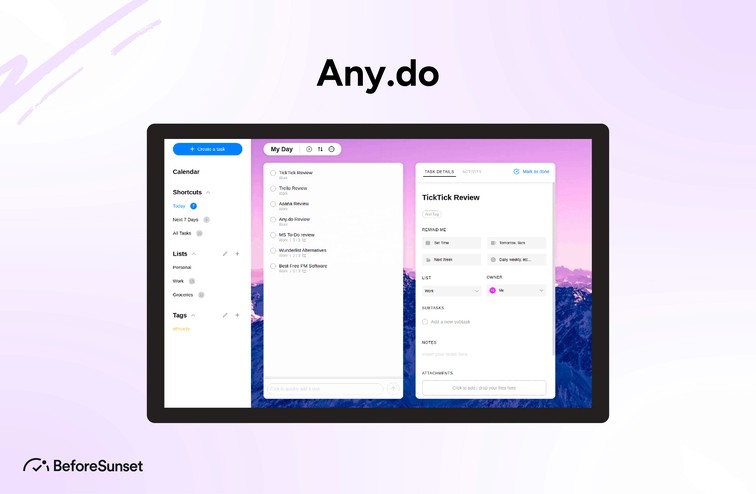
3. Any.do
The flexible task management tool Any.do enables teams and individuals to efficiently manage their projects and increase productivity. Any.do is a popular option for task management because to a number of features and its slick, user-friendly layout. Users can quickly create tasks, specify due dates, and add reminders using Any.do to make sure crucial deadlines are never missed.
Using labels and tags, the program enables task classification, allowing users to arrange their activities according to projects, priority levels, or other criteria. One of Any.do's unique features is its intelligent virtual assistant, which can aid users with task scheduling, reminder setup, and even task suggestions based on past patterns and behaviors.
This function aids in time management optimization and ensures that work is done effectively. Additionally, Any.do allows collaboration by enabling users to assign tasks to team members, share tasks and projects, and monitor progress in real-time. Users can access and change their assignments from any location thanks to seamless device synchronization, including for mobile applications and web browser extensions. Any.do's ability to integrate with well-known programs like Google Calendar, Microsoft Outlook, and Slack is another asset.
This enables smooth task synchronization and offers a uniform picture of timetables and deadlines. Any.do features a built-in calendar in addition to task management, enabling users to combine their tasks and appointments into a single, complete view. Users may keep a comprehensive overview of their commitments and due dates with the aid of this task and calendar integration. Any.do offers a user-friendly and feature-rich platform for effective task management, whether you're a professional, student, or someone handling personal responsibilities.
It is a strong competitor for individuals looking for a flexible task management solution because to its slick appearance, clever features, collaboration choices, and integration capability.

4. ProProfs Project
A powerful task management tool called ProProfs Project is created to make project management and task collaboration easier for teams of all sizes. ProProfs Project gives customers the tools they need to effectively plan, track, and carry out projects thanks to its extensive feature set.
ProProfs Project's simple project planning features are one of its standout qualities. Users may define milestones, construct project timetables, and divide large projects into smaller, more manageable tasks. Teams may use this to outline each task's objectives clearly and see the project's overall scope.
Real-time updates and visual indications provided by ProProfs Project make task tracking and progress monitoring simple. To ensure smooth collaboration and accountability, team members may manage task dependencies, change task statuses, and report their working hours. ProProfs Project is built on collaboration, allowing teams to easily discuss and exchange project-related information.
The ability for users to write comments, attach files, and engage in conversation directly inside tasks promotes effective teamwork and does away with the necessity for dispersed communication channels. Users may record and keep track of the time spent on activities and projects using the time tracking capabilities provided by ProProfs Project.
This function aids in monitoring output, locating bottlenecks, and appropriately charging clients for tasks that are time-based. ProProfs Project may easily link with well-known applications like Google Calendar, Google Drive, and Slack thanks to its integration features. By centralizing project-related information, this connection speeds data synchronization and improves workflow effectiveness.
ProProfs Project offers sophisticated reporting and analytics that provide useful information on the status of the project, the performance of the team, and the distribution of resources. These reports support stakeholders in optimizing future project planning, identifying areas for improvement, and making data-driven choices.
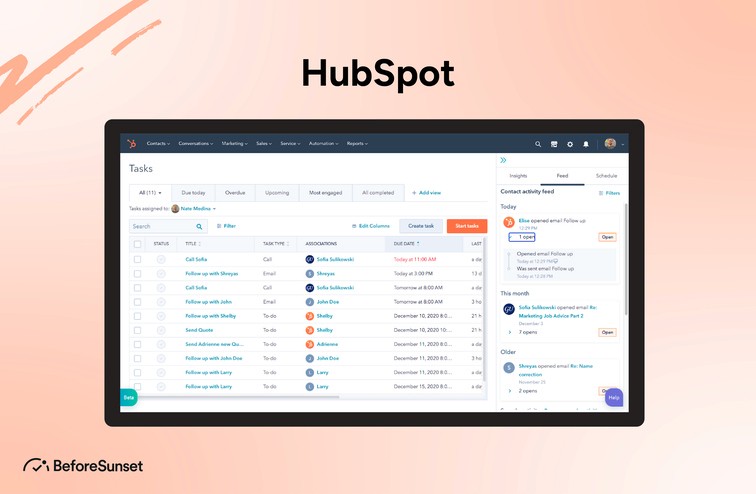
5. HubSpot Task Management Software
A robust task management tool is provided by HubSpot as part of its extensive set of CRM (Customer Relationship Management) and marketing solutions. The task management tool from HubSpot is made to support teams and individuals in remaining organized, working successfully together, and managing their duties in the context of customer connections and sales procedures. Users may create tasks, assign them to team members, give them due dates, and monitor their progress using the task management tool from HubSpot.
Within the CRM, tasks may be connected to certain contacts, businesses, transactions, or projects to ensure that they are coordinated with customer interactions and sales possibilities. The task management software from HubSpot integrates with other HubSpot solutions, which is one of its main advantages.
Users have the option of connecting tasks to marketing initiatives, sales activities, and customer contacts to get a comprehensive picture of the tasks within the larger framework of customer relationship management. The task management program from HubSpot includes collaboration tools that let team members discuss tasks, exchange files, and interact on the same platform. As a result, team members working on similar tasks or projects may more easily collaborate and coordinate. The task management tool from HubSpot's automation features is another noteworthy feature.
Based on established triggers and procedures, users may automate the creation, assignment, and notification of tasks. As a result, task management procedures are streamlined and it is made sure that the proper assignments are given to the right team members at the right time. In addition, HubSpot offers reporting and analytics tools that provide information on team productivity, task performance, and completion rates. Teams may use these statistics to pinpoint areas for enhancement, streamline their task management procedures, and arrive at informed judgments.
For companies currently using HubSpot's CRM and marketing capabilities, its task management software is a great option. When combined with other HubSpot services, it works smoothly to provide a unified platform for managing customer interactions, sales processes, and related activities. The task management software from HubSpot may increase your productivity and improve workflow for anybody working in sales, marketing, or customer support.
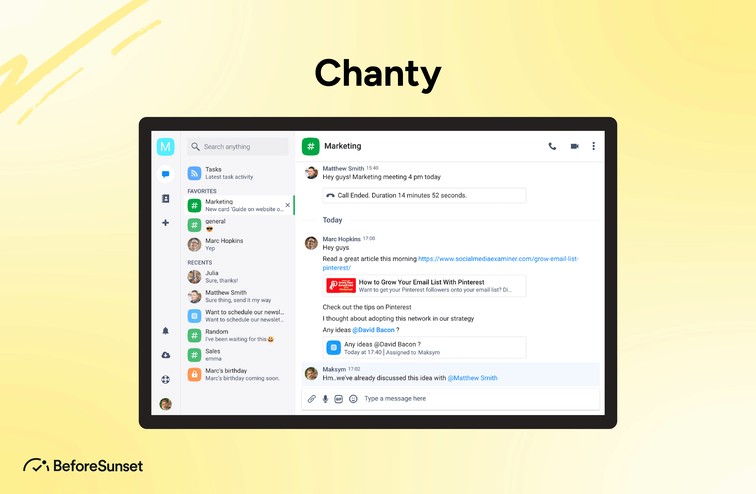
6. Chanty
Chanty is a platform for team communication and collaborative task management that promises to streamline teamwork and boost productivity. Chanty provides a simplified solution for work management and team communication with its user-friendly layout and extensive capabilities.
Users may create tasks, assign them to team members, set due dates for them, and monitor their progress using Chanty's task management tool. It is simple to manage and prioritize work within particular projects or subjects thanks to the ability to group them inside channels or private chats. Chanty's real-time collaboration features are one of its most notable characteristics. Users may make voice calls, video conferences, and instant messages to team members, allowing for smooth communication and speedy decision-making.
Team members may communicate in real-time about tasks, requirements, and updates thanks to this integrated capability. Users may be informed about work modifications, deadlines, and significant updates with Chanty's task tracking and alerting features. This facilitates effective workflow management and guarantees timely completion of jobs. Furthermore, Chanty offers interfaces with well-liked third-party applications like Trello, Asana, and Jira, enabling customers to link their task management processes with other productivity solutions they may already be utilizing.
Through the creation of a single hub for work tracking and collaboration, this connection makes task management easier. The comprehensive search features of Chanty are another noteworthy aspect. Users may quickly search for tasks, chats, files, and mentions, which makes it simple to locate pertinent data and previous discussions pertaining to certain activities. The task management system from Chanty works with teams of all sizes and in a variety of industries.
Chanty delivers a user-friendly design, effective task management features, and seamless communication capabilities to improve collaboration and efficiency whether you're a tiny startup, a remote workforce, or a huge organization.
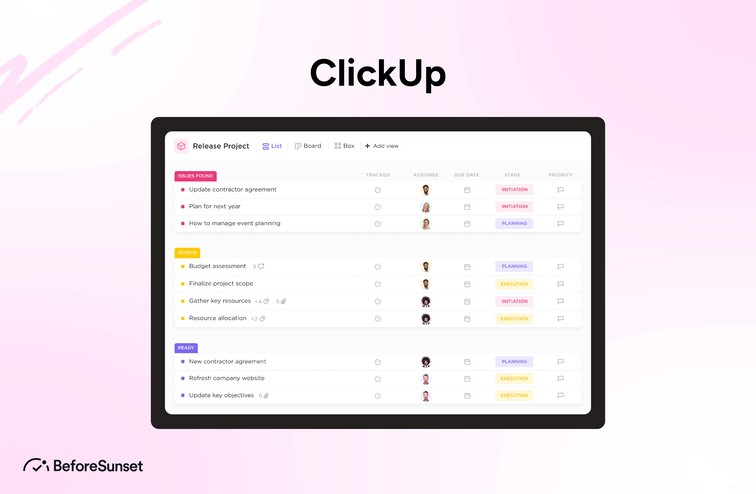
7. ClickUp
The powerful and adaptable task management tool ClickUp provides a wealth of capabilities to assist individuals and teams in streamlining their workflows and increasing productivity. ClickUp has become well-known as a complete task management solution due to its user-friendly design and vast features.
Users may create tasks in ClickUp, assign them to team members, give them due dates, and order them by urgency. The program provides a variety of task views, including list view, board view, and timeline view, giving users the freedom to arrange and visualize activities in accordance with their own tastes and project needs. ClickUp excels at collaboration because it offers tools for team members to talk about tasks, give comments, and exchange files right inside tasks.
Teammates can be notified of particular changes or activities by being @mentioned by other users. As a result, there is less need for third-party communication tools because the platform's internal communication and cooperation are improved. Using task statuses and workflows, ClickUp users may modify their workflows, enabling teams to adapt the task management procedure to their own requirements.
Additionally, task dependencies may be established to guarantee that work is done in the right order and prevent bottlenecks. A wide range of productivity tools are available with ClickUp, including time monitoring, reminders, and notifications. Users may receive notifications for task updates or mentions, measure the amount of time spent on tasks, and create reminders for approaching deadlines.
Users that use these tools are better able to prioritize their jobs and manage their time. Another advantage of ClickUp is its ability to interface with well-liked third-party programs like Google Calendar, Slack, and Zoom. By integrating ClickUp with their current tools and systems, users may synchronize their tasks and calendars, centralize communication, and optimize their workflow. Additionally, ClickUp offers sophisticated reporting and analytics services that provide users access to data on resource allocation, job completion rates, and team efficiency.
These reports assist teams in assessing their effectiveness, pinpointing areas for development, and making fact-based decisions. No matter how big or small your business is, ClickUp has a task management solution that works for you. It is a useful application for improving job management and increasing productivity because to its configurable workflows, collaboration features, integration possibilities, and reporting capabilities.
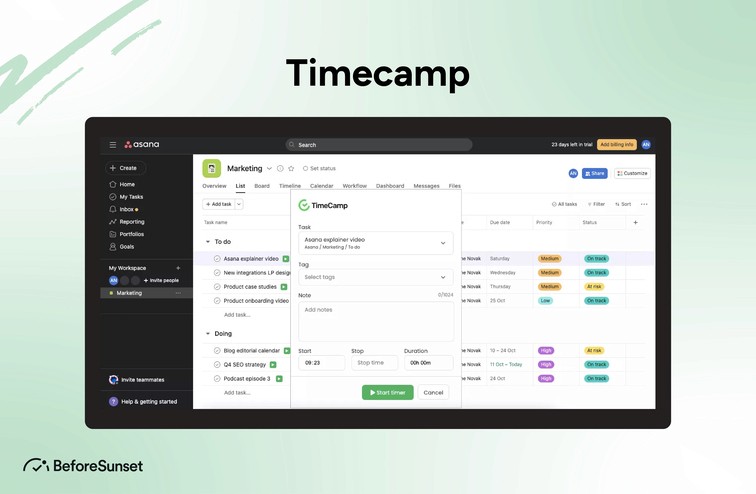
8. Timecamp
To assist people and teams efficiently manage their time, keep track of their working hours, and increase productivity, Timecamp is a complete task management and time monitoring program. Timecamp is the perfect solution for organizations and professionals wanting to obtain insights into their time utilization and enhance job management thanks to its variety of features and user-friendly design.
The automated time tracking capability of Timecamp is one of its primary features. It replaces the need for manual monitoring by automatically keeping track of the time spent on various tasks and projects. This enables users to precisely track their working hours and comprehend how time is divided among various tasks.
Additionally, Timecamp has task management features that let users create assignments, distribute them among team members, and set deadlines. Projects may be formed from tasks, offering a well-structured framework for managing and prioritizing work. Additionally, users may write comments, connect files, and add task notes, encouraging collaboration and effective communication inside the site. Users may create thorough reports on time consumption, task completion rates, and project progress using Timecamp's reporting and analytics tools.
These insights support the identification of time-consuming jobs, increased productivity, and data-driven resource allocation choices. Timecamp's ability to link with well-known project management systems like Trello, Asana, and Basecamp is another one of its strengths. This makes data synchronization simple and guarantees that task and time management are incorporated into current project procedures.
The invoicing options that Timecamp offers allow customers to create precise invoices based on recorded time and billable rates. This feature simplifies the billing procedure, making it simpler for enterprises and independent contractors to track and precisely charge their labor.
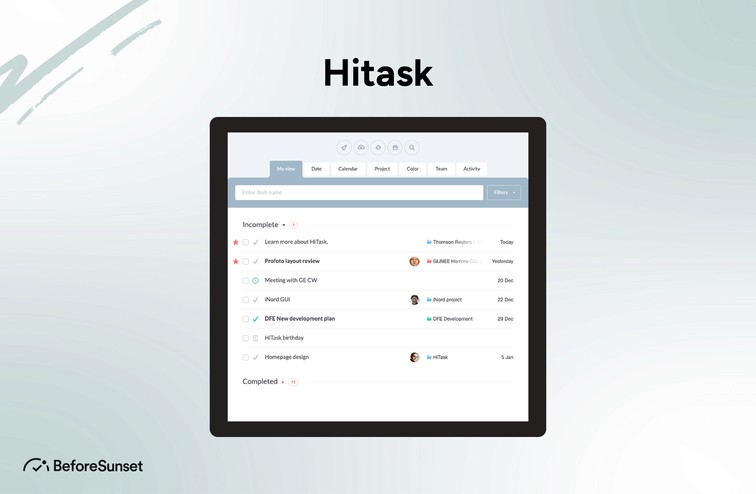
9. Hitask
Hitask is a task management tool that assists both people and teams in efficiently organizing, prioritizing, and tracking their work. Hitask strives to promote team cooperation by streamlining task management with its intuitive design and robust functionality. Hitask's task generation and assignment capabilities is one of its primary features.
Tasks may be simply created, given to team members, and given different priority and due dates. This enables explicit work delegation and team responsibility. Users can view all of their tasks in one location thanks to Hitask's single hub for task management. It is simple to explore and prioritize work based on projects or certain areas of attention thanks to the ability to group jobs into projects or categories.
Hitask emphasizes teamwork by providing tools for team members to chat, give comments, and exchange files inside tasks. This makes it easier to collaborate effectively and does away with the requirement for dispersed communication channels or outside technologies. Hitask also has scheduling features that let users make and manage deadlines, events, and appointments. Users may successfully manage their time and have a comprehensive perspective of their obligations thanks to this task management and scheduling integration.
The notifications and reminders that Hitask offers are yet another noteworthy feature. Users can opt-in to get alerts for approaching due dates, task changes, or significant conversations, helping to prevent work neglect and keep everyone up to date in real time. Hitask provides options for interface with well-known programs like Google Calendar, Outlook, and Dropbox, enabling users to synchronize their tasks and calendars and optimize their workflow by integrating with their current programs.
Additionally, Hitask offers reporting and analytics tools that provide users access to data on workload distribution, team productivity, and task completion rates. These reports assist teams in assessing their effectiveness, pinpointing areas for development, and making fact-based decisions.

10. Trello
A well-liked and widely-used task management tool called Trello uses a flexible and aesthetically pleasing method to assist both individuals and teams in organizing their work and projects. Trello has been known for its ease of use and potent features that make managing tasks simple and efficient.
Trello's primary representation of tasks and projects is represented via a board and card system. Users may make boards to represent various initiatives or areas of interest, and inside each board, they can make cards to represent specific activities or products. These cards may be moved between a variety of movable lists, including "To-Do," "In Progress," and "Completed," to show how a task is progressing.
Trello's visual format makes it simple to quickly understand a task's status and follow its progression through several phases. Users may customize cards by adding labels, due dates, attachments, checklists, and other details to give each job more meaning. Trello emphasizes collaboration since it enables team members to take part in comments sections and be assigned to certain cards. This makes it possible to communicate easily, receive information immediately, and share responsibility for activities.
Trello's integration features are yet another useful aspect. Users may link their activities with other applications and optimize their workflow by centralizing information and resources thanks to its integration with a variety of well-known programs, including Google Drive, Dropbox, and Slack. One of Trello's advantages is its adaptability.
It may be customized to fit multiple project management approaches and workflows, making it appropriate for both small teams and big companies working in a variety of different sectors. The program is widely used in both professional and personal contexts thanks to its ease of use and adaptability.
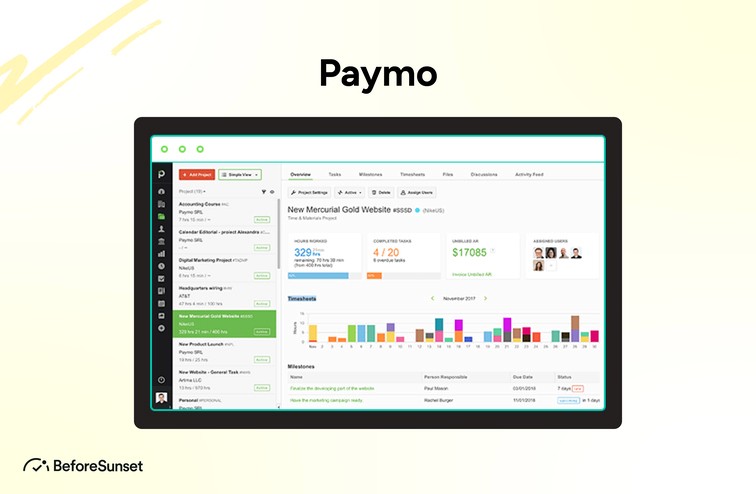
11. Paymo
To assist people and teams in effectively managing their jobs, projects, and time, Paymo is a complete task management and project management tool. Paymo provides a flexible solution for planning and managing work because to its extensive feature set and user-friendly design.
The ability to handle tasks is one of Paymo's primary features. Tasks may be created by users, assigned to team members, given due dates, and given descriptions and attachments. Projects and categories may be used to group tasks, creating a systematic framework for organizing and prioritizing work.
Paymo also has time tracking features that enable customers to precisely track the time spent on jobs and projects. A built-in timer may be used to track time entries automatically or manually. This facilitates productivity analysis, project cost analysis, and the creation of precise timesheets for invoicing and reporting needs. Users may establish and manage projects, set project budgets, specify milestones, and monitor project progress using Paymo's project management tools.
The Gantt charts and visual timelines provided by the program make it simpler to manage project timelines and resources by helping to visualize project timetables and dependencies. The communication and file-sharing capabilities of Paymo make collaboration easier. Within tasks and projects, users may share files, participate in discussions, and write comments. As a result, team members work together better and communicate more effectively.
Additionally, Paymo offers interfaces with well-known programs like Slack, Google Calendar, and Dropbox, enabling users to link their workflows and synchronize data across other programs. The ability to integrate improves workflow management and does away with manual data transmission.
Paymo also offers reporting and analytics tools that provide information on team performance, project status, and time management. Users may produce thorough reports on many elements of their job, which aids in the data-driven decision-making and process optimization.
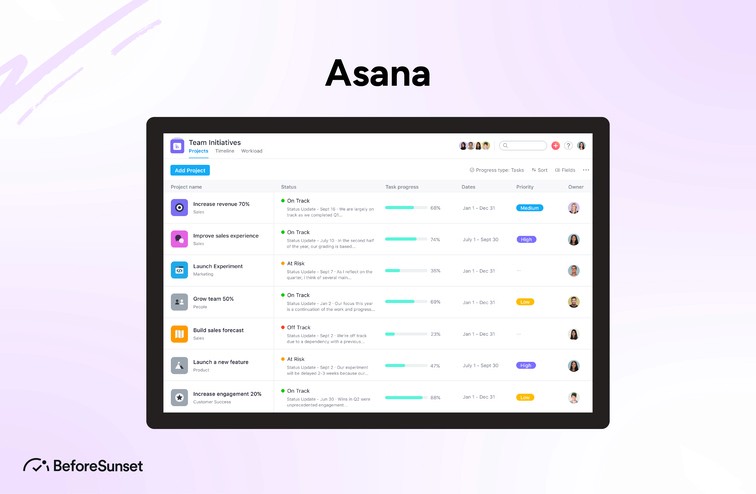
12. Asana
Asana is a highly regarded and extensively used task management tool created to assist people and teams in successfully organizing, tracking, and managing their work. Asana is known for its capacity to improve collaboration and expedite task management thanks to its rich feature set and simple design.
Asana's task tracking system, which enables users to create tasks, assign them to team members, establish due dates, and include pertinent data and attachments, is the foundation of the platform. A systematic framework for organizing and prioritizing work is made possible by the ability to group tasks into projects and categorize them according to various criteria. Users may see tasks and projects in a variety of ways with Asana's several perspectives, including list view, board view, and timeline view.
Users may select the view that best fits their tastes and workflow because to this flexibility. Asana excels at collaboration because it offers tools for team members to discuss work, exchange files, and communicate internally. Users can @mention coworkers to let them know about crucial changes or essential activities, enhancing smooth cooperation and increasing communication effectiveness.
Asana also provides connectivity options for a number of well-known technologies, such as Google Drive, Slack, and Microsoft Teams. Users no longer need to switch between several programs thanks to these connections, which integrate workflows and centralize information. Asana offers project management functionality in addition to task management, enabling users to create and manage projects, set goals, specify milestones, and monitor project progress.
Using the Timeline tool, users can visualize project timelines, dependencies, and resource allocation, giving them a complete picture of project timetables and progress. Asana has sophisticated features like custom fields, task dependencies, and automation that let users customize the program to meet their unique needs and automate repetitive chores to increase productivity.
Asana also offers reporting and analytics features that provide users access to information on team productivity, task completion rates, and project status. Users may create reports to monitor progress, assess performance, and come to data-driven conclusions about resource allocation and future planning.
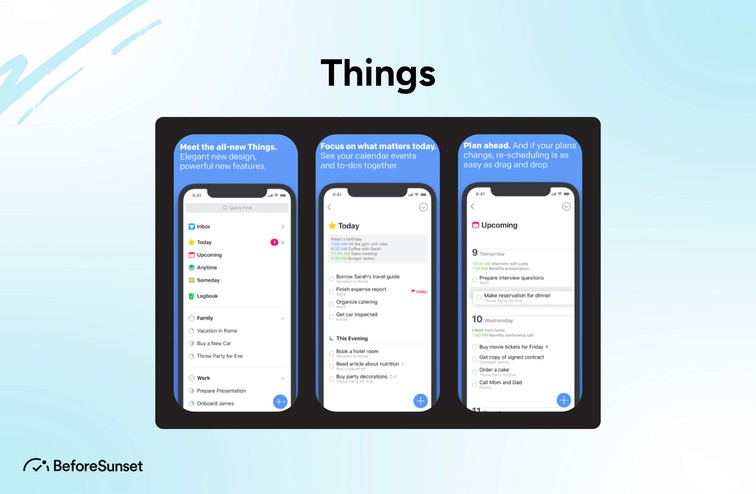
13. Things
Things is task management software created to help teams and individuals stay productive, organized, and on top of their work. It emphasizes simplicity and use while providing a clear and straightforward interface. Things' task organization system is one of its most notable aspects.
To facilitate flexible organization and simple navigation, users may create tasks and organize them into projects, regions, or tags. Users may record all pertinent information and context by assigning tasks due dates, priority, and notes. Users may examine their forthcoming tasks, due dates, and events in Things' simple and customized Today display. People may prioritize their work and maintain concentration on their everyday duties with the aid of this perspective.
Things places a strong emphasis on task management techniques including the "Today," "Upcoming," and "Anytime" lists. While the "Upcoming" list shows tasks with future due dates, the "Today" list shows tasks that are due or planned for the present day. Users can concentrate on jobs that are not time-sensitive by using the "Anytime" list, which contains tasks that have no set deadline.
Things is also compatible with the Apple ecosystem, allowing for seamless task and deadline synchronization between Mac, iPhone, and iPad devices. Users may access their work and maintain organization regardless of the device they like to use. Things also offers a variety of tools that boost productivity, such as checklists, repeating tasks, and reminders.
Users may utilize checklists to divide difficult jobs into smaller, manageable steps and create reminders to make sure crucial chores are not forgotten. For jobs that occur often, recurring tasks may be set up, saving time and effort in task development.
Things is appropriate for individuals and small teams that desire a basic task management solution since it places an emphasis on simplicity and a focused user experience. Users looking for a user-friendly and productive work management application favor it because of its simple design, clear interface, and efficient categorization system.
Benefits of Using a Task Management Tool
A task management application has several advantages for both individuals and teams. Some of the main benefits are as follows:
Structure and Organization: Task management solutions offer a well-organized framework for managing and arranging activities. Users may create, classify, and prioritize jobs to make sure nothing is missed. This promotes organization and guarantees that team members are informed of their duties and due dates.
Improved Productivity: Productivity is increased thanks to task management systems, which give users a central location to track and manage their work. Users can focus on what has to be done, establish priorities, and readily visualize their work. Time management and effective task completion are made possible by the capacity to assign tasks, establish deadlines, and monitor progress.
Collaboration and Communication: Task management software frequently provide collaboration capabilities that help team members communicate and work together efficiently. Within tasks, users may exchange files, post comments, and assign tasks to certain team members. Even when working remotely or across time zones, this simplifies communication, improves cooperation, and keeps everyone informed.
Transparency & Visibility: Task management technologies provide transparency into the status of tasks and projects. The visibility of task progress, changes, and dependencies among team members promotes transparency and lessens the possibility of miscommunication or duplication of work. This openness encourages responsibility and gives managers a clear picture of the workload of their teams and the status of their projects.
Efficiency and Time Monitoring: Many task management programs have time monitoring functions that let users keep track of the time spent on each activity. This makes it easier for individuals and groups to discover time-consuming jobs, evaluate productivity, and plan their time more effectively. Additionally, reliable data from time tracking is provided for client invoicing, report generation, and project cost analysis.
Reminders and Notifications: Reminder and notification capabilities are frequently included in task management software to help users remember crucial tasks and deadlines. In order to keep on track and prevent missing important tasks or milestones, users can get reminders for approaching due dates, task changes, or remarks.
Workflow automation and Integration: Task management software frequently interface with other tools and programs, enabling smooth data transmission. Information is centralized, redundant data entry is eliminated, workflows are streamlined, and time and effort are saved through integration with calendar applications, project management software, or communication tools.
How to Choose the Right Task Management Tool for Your Business?
It's crucial to take into account a number of aspects while selecting the best job management solution for your company. Assess your company's demands and requirements first. Decide which precise features and functionalities would be most helpful to your team as well as the main problems you wish to solve.
Think of elements like task organization, teamwork skills, integration possibilities, and scalability. Consider the tool's usability, user interface, compatibility with your current systems, and workflows. Pay attention to the tool's cost, support options, and security features as well. Reading customer evaluations and getting referrals from other companies in your field are also beneficial.
You may choose a task management solution that best suits your needs and positions your team for success by taking these variables into account and coordinating them with your company goals.

